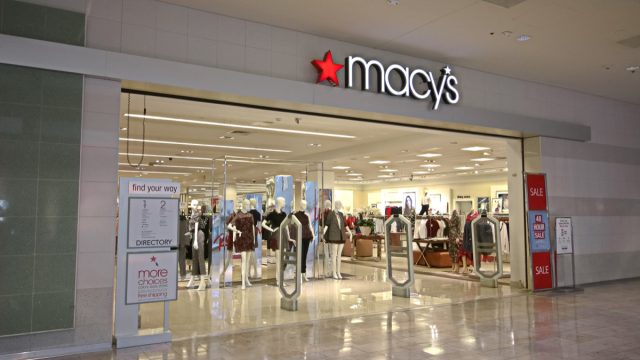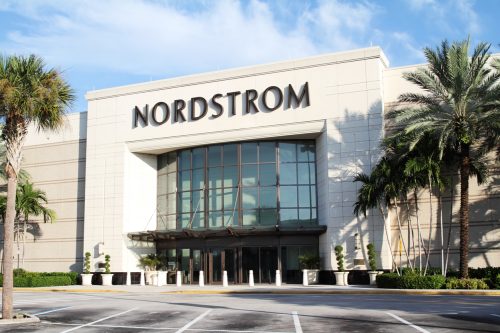Shoppers Are Turning Away From Nordstrom and Macy’s, Data Shows—Here’s Why

When it comes to heavy hitters in retail, stores like Nordstrom and Macy’s have historically led the pack. These big-name department stores withstood the test of time, with their brick-and-mortar locations surviving what some called “the retail apocalypse,” as well as the COVID-19 pandemic. Now, many believe that the biggest threat to in-store shopping is rising crime, as many retailers have been forced to put merchandise under lock and key. But new data suggests different reasons for declining in-store sales. Read on to find out why shoppers are turning away from Nordstrom and Macy’s—and how these retailers are combatting the crisis.
READ THIS NEXT: Shoppers Are Turning Away From Lowe’s and Costco, Data Shows—Here’s Why.
Major retailers have closed brick-and-mortar locations.

It feels like there have been constant news reports about retail theft, most notably in the San Francisco Bay Area, where stores are exiting at an accelerated pace. Nordstrom is one of the 26 stores that have pulled out of the city since 2020, bringing retail vacancy up to 18 percent at the end of May. This was a stark contrast to the 9 percent retail vacancy in malls nationwide and 3 percent for general retail, Bloomberg reported, citing the CoStar Group.
Walmart also shuttered dozens of stores this spring—and while some again blamed crime, the big-box retailer held steadfast to its position that shuttered stores were “underperforming.” As a matter of fact, there may be more to Walmart’s reasoning, as new data suggests that shoppers are just less interested in shopping in-store.
Crime isn’t the sole issue.

As reported by Bloomberg, there’s more to the story—and one can’t blame crime alone for shifting shopping patterns and decreased in-store spending. The outlet points out that inflation may have something to do with decreased spending in general, but at the end of the day, shoppers are drawn to the speed and convenience of online shopping.
In the U.S., foot traffic at retail stores, in general, was down 8 percent in March, compared with the same time in 2019, Bloomberg reported, citing data from Placer.ai. In downtown areas, these numbers were even starker, as foot traffic in May was down by 21 percent when compared with 2019, according to Springboard.
But while shoppers may not be eager to venture out and shop in person—especially at larger department stores—both Nordstrom and Macy’s are taking action to win their customers back.
RELATED: For more up-to-date information, sign up for our daily newsletter.
Both Nordstrom and Macy’s are shifting focus to smaller stores.

Interestingly enough, for the fiscal quarter ending Jan. 28, both Macy’s and Nordstrom reported a decline in online sales, and net sales at Macy’s were down by 4.6 percent, while Nordstrom’s net sales were down by 4.1 percent.
But for Macy’s, there was an exception. Sales at smaller-concept stores—like Market by Macy’s—were one area where the retailer saw sales growth, Macy’s CEO Jeff Gennette said during a March 2 earnings call.
Also during the earnings call, Macy’s announced plans to open five more of these off-mall, small-format stores in 2023 (four Market by Macy’s and one Bloomie’s), moving further away from “large regional shopping meccas,” CoStar News reported.
These smaller stores are typically around 30,000 to 40,000 square feet—a far cry from the 250,000-square-foot department stores they typically occupied—and located in shopping centers as opposed to malls. According to experts, these mini models are more appealing to shoppers.
“Retailers have been seeking alternatives to mall strategy over the past few years and are opening more stores in grocery-pharmacy-anchored, lifestyle and ethnically dominant shopping centers in an effort to attract more regular customers and repeat business—those who are less interested in browsing the store and instead want to get in and out as quickly as possible,” Anjee Solanki, U.S. national director of retail for Colliers, told CoStar News.
Nordstrom was also in the spotlight with its plans to close both its main store and its off-price store, Nordstrom Rack, in San Francisco. However, similar to Macy’s, the retailer has been opening smaller-format stores, Bloomberg reported.
This trend isn’t anticipated to slow down.

This trend toward smaller stores is likely here to stay, as shoppers don’t need as much space to browse, especially when they also have the option to compare prices and find what they need when shopping online, Bloomberg reported.
By 2027, retail e-commerce sales in the U.S. are predicted to reach $1.74 trillion and account for over 20 percent of total retail sales, per data from market researcher Insider Intelligence.